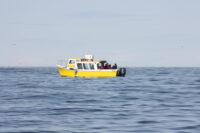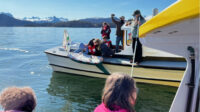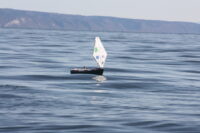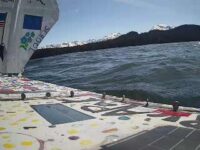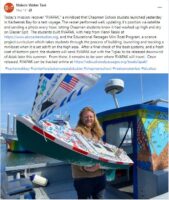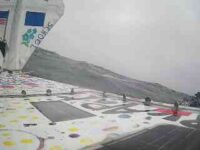Updates:
1st Voyage
-
About us and APAK
This miniboat project is supported by the Bureau of Ocean Energy Management and is part of the work of a collaborative group called STUDENT ENGINEERS ADVANCING OCEAN TECHNOLOGY (SEAoTech). The goal of SEAoTech is to bring new hands-on STEAM programs to communities in the Homer, Kachemak Bay, and Lower Cook Inlet area of Alaska. One of the programs is the Educational Passages Miniboat Program, and the other is the Open CTD project. Partners include: Blue World Research Institute, the Center for Alaskan Coastal Studies, Blackbeard Biologic, and Educational Passages.
Students at Chapman School in Homer, Alaska have been working closely with Center for Alaskan Coastal Studies staff and their teacher, Mr. Herbst, on the project. Together they prepared their miniboat voted to name it APAK, which stands for Anchor Point AK (Alaska).
-
May 11, 2022 - Launched into Kachemak Bay
The first voyage of APAK began when Chapman School students launched it into Kachemak Bay on May 11, 2022.
The APAK is outfit with a sensor pack that is recording air temperature, water temperature, pitch, and even has a camera on deck. Here is a picture from the boat as it was heading through Peterson Bay.
Right now miniboat APAK is sailing in coastal waters of Alaska and here is what it is seeing as it sails! Thanks to all partners and students involved in the @BOEM funded #SEAoTech project. We will share more details soon 😎🤩 pic.twitter.com/fw9vJdWd17
— Educational Passages (@miniboats) May 11, 2022
-
May 11, 2022 - Landed in Peterson Bay
It sailed for an hour and 15 minutes before landing on the other side of Peterson Bay. It was soon recovered by Water Taxi Captain Garth who took it back out and relaunched it. Details about the second voyage are below.
-
Voyage 1: 1 hour, 15 minutes
Read above for all the details of the APAK and its first voyage.
2nd Voyage
-
May 11, 2022 - Relaunched for 2nd voyage in Kachemak Bay
The second voyage of APAK was set to sea by Captain Garth in Kachemak Bay.
-
May 12, 2022 - Landed and recovered in Halibut Cove
-
Voyage 2: 4 hours
Read above for all the details of the APAK and its second voyage.
Sensor Data
Click on link below to explore sensor data
3rd Voyage
-
Sensors and Images from the Deck
The boat has two GPS systems onboard. The reports from the main GPS are showing on the map at the top of this page here (which updates once per day with location reports every 6 hours). Here below is where you can see the data reporting from the second GPS which is connected to the sensor package. In addition to reporting location with a secondary GPS tracker, this system is also collecting air temperature, water temperature, and orientation.
There is also a camera connected to the sensor pack, which took lots of pictures during its voyage so far. Here are a select few:
-
July 2022 - Short voyage near Aleutian Islands - landed on Amlia Island
The APAK was launched for a 3rd voyage near the Aleutian Islands and made landfall after one week.
Read more about the project and its drop off to the R/V Tiglax in the Homer News, July 20, 2022: Chapman School’s student-made mini-boat journeys to Bering Sea.
The boat is on Amlia Island. Can you help us recover it safely? Click here to download one page of information below.
SEEKING ASSISTANCE WITH RECOVERING 1.5m UNCREWED MINIBOAT NAMED “APAK” FROM COASTLINE OF ALEUTIAN ISLANDS IN ALASKA
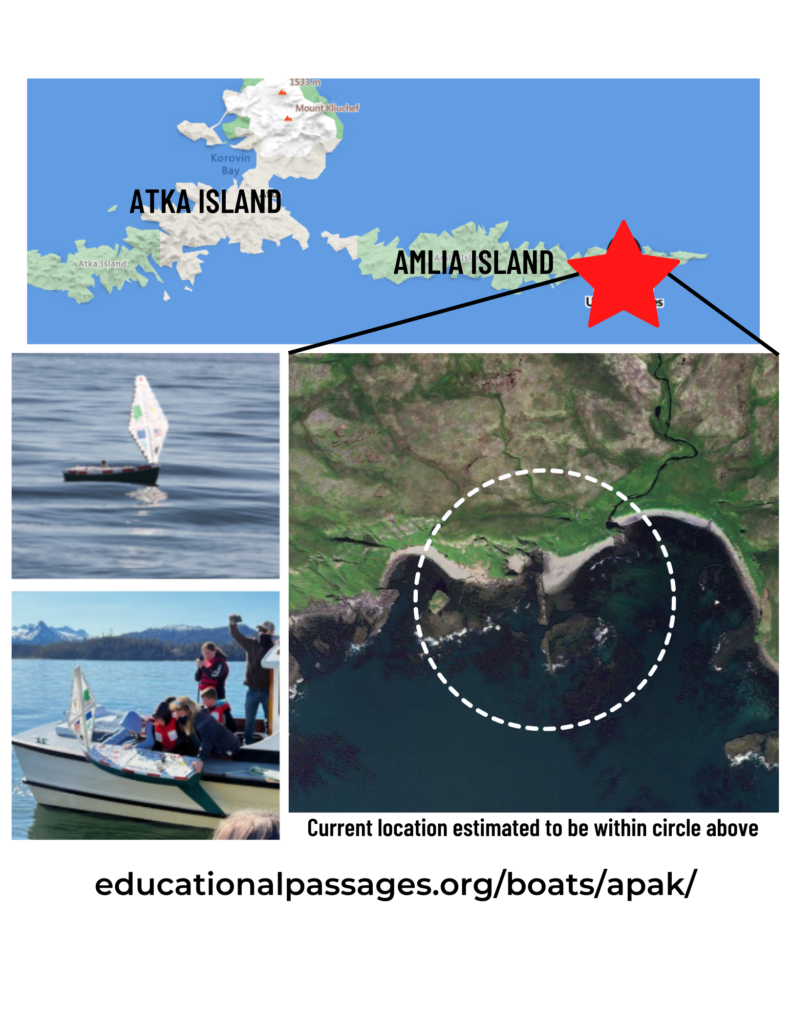 An uncrewed 1.5m-long educational sailboat (“MINIBOAT,” pictured here) has landed on AMLIA ISLAND (east of Atka) in the Aleutian Islands, Alaska. The GPS is reporting from 52.062047958374, -173.19251060486.
An uncrewed 1.5m-long educational sailboat (“MINIBOAT,” pictured here) has landed on AMLIA ISLAND (east of Atka) in the Aleutian Islands, Alaska. The GPS is reporting from 52.062047958374, -173.19251060486.With the help of USFWS, the RV APAK, which is what the students named their miniboat, was launched offshore of the Aleutian Islands in July 2022 and collected temperature and drift information for 9 days before it landed (pink line on map). Students and participants in the project from Homer, AK are seeking assistance to have it recovered and brought back to the Center for Alaskan Coastal Studies. It is part of a student project to study ocean science and provide a cultural exchange when it lands. The students would also like to see any pictures and videos that are possible so they can learn more about where the boat landed. Please explore the webpage here to learn more about the project and story so far.
If you have any information about the area or can assist with recovering the uncrewed vessel, please contact Cassie from Educational Passages at cassie@educationalpassages.org. It is an uncrewed vessel, like a “message in a bottle”. Pictures show the boat when it was first launched. Current condition may differ.
This miniboat project is supported by the Bureau of Ocean Energy Management and is part of the work of a collaborative group called STUDENT ENGINEERS ADVANCING OCEAN TECHNOLOGY (SEAoTech). The goal of SEAoTech is to bring new hands-on STEAM programs to communities in the Homer, Kachemak Bay, and Lower Cook Inlet area of Alaska. One of the programs is the Educational Passages Miniboat Program, and the other is the Open CTD project. Partners include: Blue World Research Institute, the Center for Alaskan Coastal Studies, Blackbeard Biologic, and Educational Passages.
This miniboat project is supported by the Bureau of Ocean Energy Management and is part of the work of a collaborative group called STUDENT ENGINEERS ADVANCING OCEAN TECHNOLOGY (SEAoTech). The goal of SEAoTech is to bring new hands-on STEAM programs to communities in the Homer, Kachemak Bay, and Lower Cook Inlet area of Alaska. One of the programs is the Educational Passages Miniboat Program, and the other is the Open CTD project. Partners include: Blue World Research Institute, the Center for Alaskan Coastal Studies, Blackbeard Biologic, and Educational Passages.


